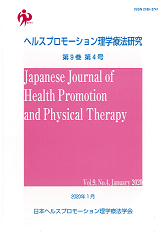Volume 9, Issue 4
Displaying 1-7 of 7 articles from this issue
- |<
- <
- 1
- >
- >|
ORIGINAL ARTICLES
-
Article type: original article
2020Volume 9Issue 4 Pages 161-165
Published: January 31, 2020
Released on J-STAGE: February 07, 2020
Download PDF (492K) -
Article type: original article
2020Volume 9Issue 4 Pages 167-173
Published: January 31, 2020
Released on J-STAGE: February 07, 2020
Download PDF (788K) -
Article type: original article
2020Volume 9Issue 4 Pages 175-180
Published: January 31, 2020
Released on J-STAGE: February 07, 2020
Download PDF (317K)
SHORT REPORT
-
Article type: short report
2020Volume 9Issue 4 Pages 181-186
Published: January 31, 2020
Released on J-STAGE: February 07, 2020
Download PDF (288K) -
Article type: short report
2020Volume 9Issue 4 Pages 187-193
Published: January 31, 2020
Released on J-STAGE: February 07, 2020
Download PDF (623K) -
Article type: short report
2020Volume 9Issue 4 Pages 195-200
Published: January 31, 2020
Released on J-STAGE: February 07, 2020
Download PDF (315K)
FIELD REPORT
-
Article type: field report
2020Volume 9Issue 4 Pages 201-204
Published: January 31, 2020
Released on J-STAGE: February 07, 2020
Download PDF (256K)
- |<
- <
- 1
- >
- >|
